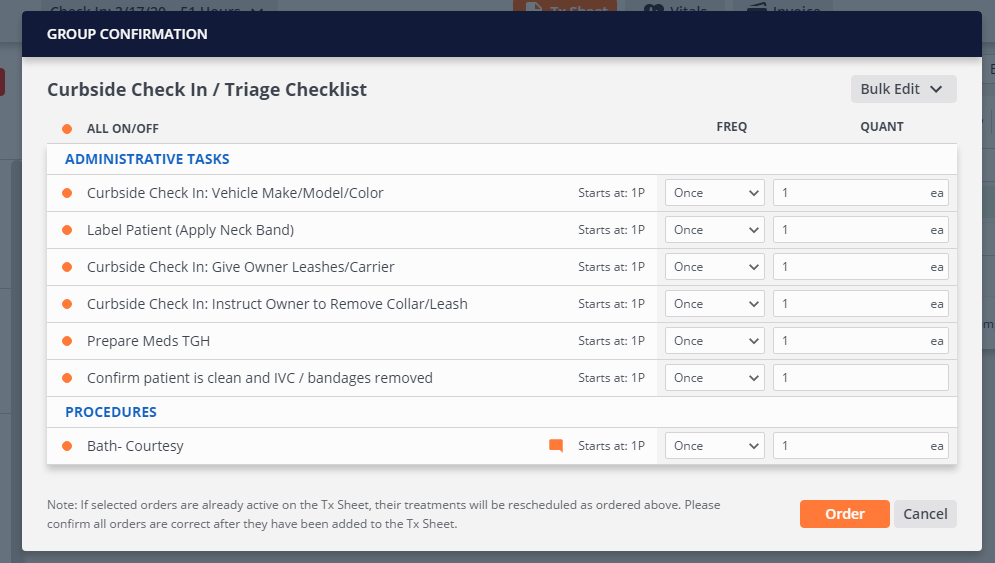Thanks for all of the feedback on our practical coronavirus-related guides, which continue to be updated with your contributions.
I’ve spent the majority of my time talking with hospital leaders this week, and I've learned a ton.
There’s a lot of necessary improvisation going on out there. 👏
One example? Curbside Triage and Check-In is now a thing, since many hospitals have banned clients from being in the building as a way to protect them and the team.
Here is some organized shared learning about this unexpected workflow phenomenon. I hope it helps.
📣 Prepare Your Community
- Get your mind right on workflow. We’ve posted on this.
- Draw up a proposed plan (see example workflow below).
- Call an all-hands meeting (on Zoom). Get your team on the same page and let them ask questions. You’ll solidify holes this way.
- Get clear explainers sent out (ie, for clients, referring vets).
- Update your website with messaging (here’s a well-done example).
- Make signage.
- Utilize social media.
📺 Leverage Digital As Much As Possible
Our understanding of the virus causing COVID-19 is evolving rapidly.
There is new concern about it living in the environment/on surfaces (see Dr. Weese’s new article on this). Thus, out of an abundance of caution, transitioning everything to digital is recommended.
Here’s what I’ve seen hospitals doing:
- Going cash/checkless when possible (take credit cards over the phone).
- Leveraging texting. If you don’t already text with clients, Google Voice is free and simple to use in a pinch if you don’t want to give out personal cell phone numbers. You can set up a number for your hospital and log into a dashboard, where you can text from the computer.
- Reducing/eliminating paper forms for check-in. You have two simple options here: Take the info verbally over the phone, or send a link to a simple Google form. With this option, when a client shows up, you can text them the link to the form and they fill it out, which populates a spreadsheet you and your staff can see.
🦺 Prioritize Patient Safety
Whenever you're instituting completely novel workflows (in this case, with little training or experience), it is especially important to focus on patient safety procedures.
Here’s how I’ve seen hospitals prioritize safety measures:
- Use checklists for everything so you get it right.
- Immediately label patients. A neck band with key info such as name and phone number is a must to prevent mix-ups.
- Small pets should be in carriers (be ready to provide clean ones).
- Use your hospital’s slip leads only (and double leash).
- Hand off in a fenced area only, if possible.
- Wear protective gear, including new gloves.
- Control the chaos by having someone manage cars pulling up.
- Protect from weather and noise. Consider using cotton balls as ear plugs.
- Provide good lighting at night.
- At discharge, check that IV catheters and bandages aren't left in place, medications are provided, and patients are clean.
- Now’s the time to pay close attention to all things medication safety.
🚥 Example Workflow to Get You Started
- Have a leader organizing the workflow on each shift.
- Use the airport model: Have two separate areas (Arrivals and Departures) and clearly label so pet owners can see from their cars.
- Create a separate area for Expedited Check-In (critical patients).
- Have a brief drive-through discussion with the client. Record vehicle make/model/color. Create a document to guide your team on what to ask at this step. Limit to necessities.
- Noncritical patient? Have the client park and call for further instructions.
- Critical patient? Move the client to a separate area where a nurse triages immediately.
- Take key information over the phone or with a digital form.
- Text or email the client a link to information about your new Curbside Check-In/Triage process.
- Ask the client to remove collars/leashes and place hospital slip leads on the patient in preparation for the visit.
- When it’s time, have the client hand off the patient safely to the nurse (ideally in a fenced area).
- Have a neck band ready with key info including phone number. Confirm it is correct with the client and apply to every patient.
- Instruct clients they all must wait in the car (no congregating outside or inside the hospital).
- Triage/examine the patient (+/- bath if appropriate) in the hospital. Follow normal procedures for creating estimates, admissions, deposits, and updates. All communication with the client from here is handled virtually.
- Discharge by giving instructions and taking payment virtually.
- Hand off the patient in the same controlled/safe manner.
- Clean everything before and after every patient and client.
- Use protective equipment (gown/gloves) when interacting.
- Have clear signage.
- Wash those hands!
🙌 Leading Your Team During Change
First, remember that your staff is likely dealing with a lot of personal stress on top of this new change. Coach your team that basic common sense should prevail and there won’t be a policy for every situation.
Allow slack in your new operations. Everyone will do things slightly differently, procedures will evolve, and learning is expected.
Take notes and communicate new lessons learned to the team daily.
👨👩👧👦 What About Inpatient Visits?
Most hospitals I’ve talked to are no longer allowing visitors. While this obviously isn’t ideal, especially for critical patients, video visits are a viable option.
For both exams and visits, this is a perfect opportunity to leverage video chat. Your clients can be there every step of the way.
Get a few “visit” or “exam room” laptops, iPads, or Chromebooks with video cameras built-in, and schedule video calls with your clients (see Coronavirus-Induced Telemedicine for tips).
Another tip I’ve seen work well for an added personal touch: texting photos or videos of the patient while they are separated from the owner.
🌸 What About Euthanasia?
This is where things get tricky because appropriate social distancing becomes a challenge. In my opinion, telemedicine just can’t cut it in this important and delicate part of what we do.
Here are some tips:
- Wear protective equipment.
- Use an isolation unit if available (dedicated entrance).
- Dedicate a private outside space (if weather allows).
- Outfit these areas with disposable/washable “furniture” such as a comfortable picnic blanket.
- Use hand sanitizer and cleaning measures between every client and medical team interaction.
🧡 Can Instinct Help?
Absolutely. Instinct is built for this and could be your curbside home base with the Ready to Go, Ready to Admit, and Critical buttons.
One thing we’ve also seen is creating ward areas for your parking lot and alerts for this new workflow. We’d also recommend adding vehicle information in Instinct.
You could create a new set of orders (and a new Instinct checklist) for your teams to work from and call it the “Curbside Check-In/Triage Checklist.”
Here are tips on that: Using Instinct During Pandemic Mode.
Here’s what it could look like:

Any administrator at your hospital can create this, or reach out to support@instinct.vet and we’ll be happy to do it for you!
If I’ve observed one thing over the past few days, it’s that veterinary professionals are one scrappy, creative population.
Keep calm, and keep being awesome!
Want more info? See our related Novel Coronavirus + Veterinary Hospital Survival Guide.
